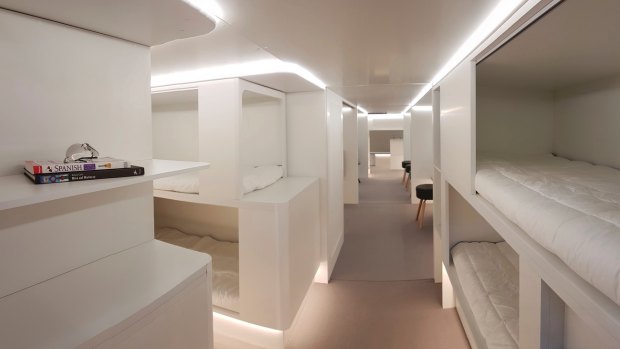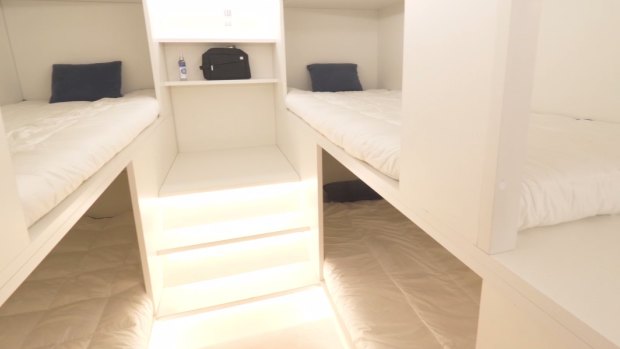This was published 6 years ago
Plane sleeping compartments: Is this the cheaper option to lie-flat beds in business class?

An artist's impression of sleeping compartments being planned for the cargo holds of passenger aircraft.Credit: Airbus
What's the one thing we all want on a long-haul flight. A bed, right? Room to stretch out, get some quality down time, arrive at your destination feeling almost human. The bed is right there, behind the curtain, in that gilded upland known as business class. But what if there was another, cheaper lie-down option?
At the 2018 Aircraft Interiors Expo held in mid-April in Hamburg, Airbus and seat manufacturer Zodiac Aerospace announced plans to develop a passenger sleeping module fitted inside the cargo hold of the Airbus A330 and A350 family aircraft. Zodiac is a leading designer of aircraft passenger seats, and one of the primary suppliers for Airbus and Boeing aircraft. According to Airbus this could happen as early as 2020.
A mock-up of the sleeping module shows a central corridor with bunk-bed sleeping compartments on either side. The publicity image also shows several stools, which suggest the possibility of make-up stations, adding a slight air of unreality to the concept. Nonetheless, anything that adds to passenger comfort on long-haul flight is worth exploring.

Airbus and Zodiac Aerospace are developing passenger sleeping compartments.
See also: How an aircraft seat is made: Take a top-secret tour
A passenger sleeping module would dovetail perfectly with Alan Joyce's recent expression of interest in an aircraft with sleepers for the non-stop Project Sunrise flights the Qantas CEO hopes to see happening from east coast Australia to London and New York, starting in 2022.
Qantas already operates the A330, and according to Airbus the sleeper module would be available as a retrofit, but it's likely the only aircraft that would really interest Qantas with this concept is the Airbus A350-900ULR, the world's longest-range aircraft. Airbus claims a range of 9700 nautical miles for the Airbus A350-900ULR. That's more than enough to make the distance from Sydney to London in a single bound, and Melbourne to London is slightly less while the non-stop flight to New York is shorter still. Both the range and the sleeper module would seem to make the A350-900ULR the logical choice for Qantas although the airline has no orders with Airbus for that particular aircraft.
Bunk-style sleepers in the air are far from new. Back in the 1950s, Boeing Stratocruisers and Douglas DC-6s operating on the trans-Atlantic route offered bunk-bed sleeping compartments based on the sleepers found aboard long-distance trains. The concept died when jet aircraft shrank the time it took to cross the Atlantic.
There is also a modern template for bunk-style sleepers in the crew rest compartments found aboard aircraft operating long-haul routes. While the steep staircases and narrow corridors typical of these crew rest compartments might not be a problem for agile flight crew, some flyers are probably going to require a little more navigating room.
See also: Best business class seats - not all seats are equal
The emergency exit for some of these crew rest compartments is a removable floor section of the main cabin. That will need some careful thinking for a passenger sleeping compartment that complies with the 90 seconds for full cabin evacuation stipulated by the US Federal Aviation Administration.
While a sleeper berth sounds like a tantalising prospect as an add-on option for economy-class flyers, what's it going to cost? In all probability, it's going to be an economy class add-on, definitely not an alternative to an economy class seat, with a price tag probably not too far south of a seat in business class. Business class is highly lucrative for an airline, but at the end of the day you can forget the privileged service, the champers, the meals-on-demand and the noise cancelling headphones. The No. 1 motivation for anyone choosing business class on long-haul flights is the lie-flat seat. Why would any airline risk diluting the appeal of its business class seats, and that revenue, by offering a competing product at a substantial reduction?
Airlines might also discover that those cargo-hold sleeping modules could also be made to accommodate a bunch more seats, and the temptation will be too hard to resist. Why not? Remember, early model Boeing 747 aircraft once featured spacious piano bars and clubby lounges, later sacrificed so that airlines could get a few more paying bodies on board. And Airbus has just recently named Qantas as the first customer for its A380 Cabin-Flex option, a new cabin configuration that allows an airline to add more seats on the A380's upper deck.
See also: New standing seats designed to squeeze 20 per cent more people into plane cabins
Sign up for the Traveller newsletter
The latest travel news, tips and inspiration delivered to your inbox. Sign up now.